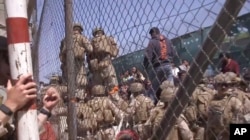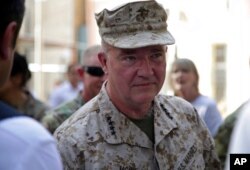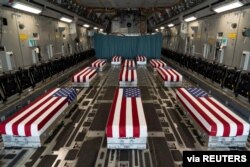It was an attack that left a lasting mark on the U.S. in the waning days of its withdrawal from Afghanistan — a bombing and apparent follow-on attack at Hamid Karzai International Airport in Kabul that left 13 American troops and more than 170 Afghans dead.
But a just-completed investigation by the U.S. military finds that much of what officials thought they knew about the August 26 attack at the airport's Abbey Gate was wrong. In particular, the probe concludes that comments by senior commanders who argued it was part of a large and well-coordinated plot by the Islamic State's Afghan affiliate were misguided.
"This was not a complex attack," Army Brigadier General Lance Curtis told reporters Friday, detailing the investigation's findings.
"It was a single blast, and it did not have a follow-on attack," Curtis said, still placing the blame with the group known as IS-Khorasan.
In the immediate aftermath of the attack, which put U.S. forces in Kabul on heightened alert, senior U.S. commanders said there were two suicide bombers and that gunmen fired on both the crowd and U.S. troops following the explosions.
But Curtis and other military investigators now say that the evidence does not back that up, and that reports of a firefight with IS gunmen can be better explained by the nature of the bomb itself — made with about 9 kilograms (20 pounds) of military-grade explosives and ball bearings — and by the immediate response of U.S. and British troops in the vicinity of Abbey Gate.
The ball bearings, according to the investigators, created injuries that looked "remarkably similar to gunshot wounds." And, they said, the reports of a firefight with militant gunmen likely were the result of U.S. troops on the ground hearing the echoes of warning shots fired by their colleagues within the confines of the security perimeter.
Commander of U.S. Central Command, General Kenneth "Frank" McKenzie, who helped oversee the U.S. withdrawal from Afghanistan, praised the investigation, even though the conclusions differed from what he and others had said in the days following the deadly bombing.
"This was a terrible attack that resulted in tragic outcomes and a horrific loss of life, both Afghan and American," McKenzie said. "While nothing can bring back the 11 Marines, one soldier and one sailor that we tragically lost in this attack, it is important that we fully understand what happened. Their sacrifice demands nothing less."
Sources of evidence
Investigators said they based their findings on eyewitness testimony, video from a drone flying over the airport in the aftermath of the attack, forensic evidence and findings of medical examiners. They said, though, that they did not talk to any Afghan witnesses as U.S. troops had already left Afghanistan by the time their inquiry began.
They also emphasized that the evidence indicated all the deaths and injuries had been caused by the bomb itself, which they said was powerful enough to send shockwaves through the tightly packed crowds at Abbey Gate, spreading 50 meters from the detonation site.
"The disturbing lethality of this device was confirmed by the 58 U.S. service members who were killed and wounded despite the universal wear of body armor and helmets that did stop ball bearings that impacted them but could not prevent catastrophic injuries to areas not covered," McKenzie said.
Military officials said the power of the explosion was also enough to cause some troops to suffer from traumatic brain injuries.
Investigators further said there was no proof that anyone was hurt or killed when U.S. and British forces fired a series of warning shots while targeting a perceived threat following the explosion. They also said the probe found no evidence that the Taliban, who at that point were coordinating with U.S. forces on airport security, knew anything of the looming attack.
Asked if there was anything the U.S. could have or should have done differently to prevent the attack, Curtis said no.
"Based on our investigation at the tactical level, this was not preventable," he told reporters. "The [U.S. military] leaders on the ground followed the proper measures, and any time there was an imminent threat warning, they followed the proper procedures."
Following the attack on Kabul Airport's Abbey Gate, U.S. President Joe Biden said the Islamic State's Afghan affiliate, known as IS-Khorasan, would be held responsible.
"To those who carried out this attack, as well as anyone who wishes America harm, know this: We will not forgive," Biden said in a nationally broadcast address. "We will hunt you down and make you pay."
"We will respond with force and precision at our time, at the place we choose and the moment of our choosing" he said.
The Abbey Gate bombing also left the U.S. military in Afghanistan on heightened alert and possibly contributed to a botched airstrike three days later that killed as many as 10 civilians, including an aid worker and seven children.















